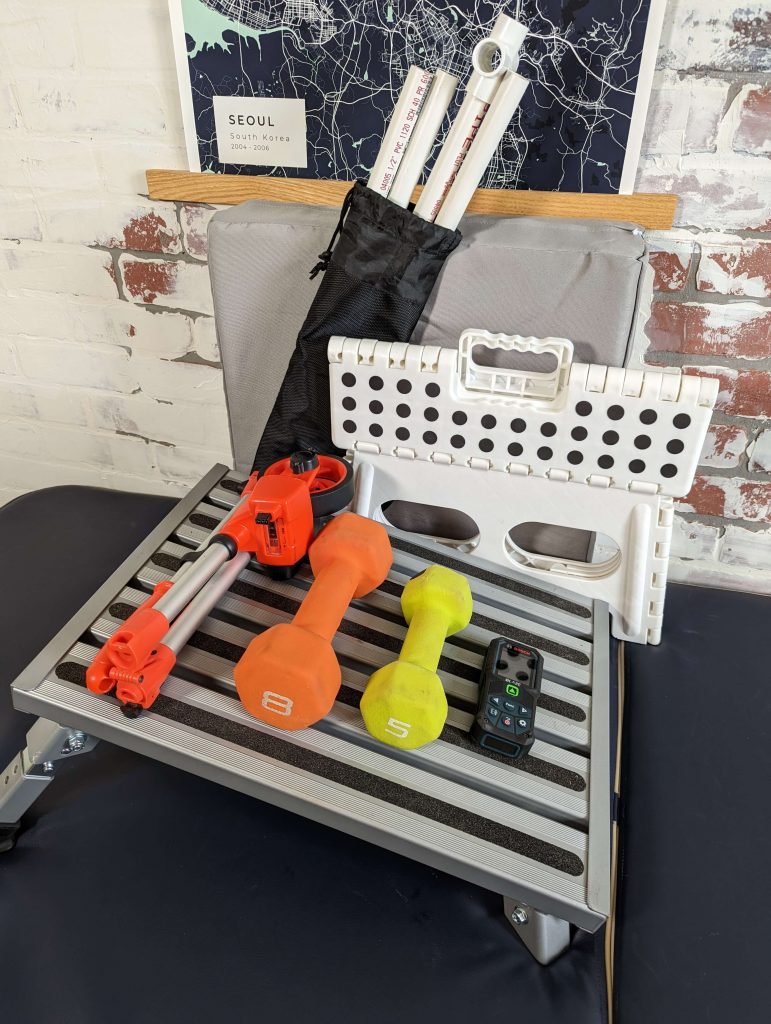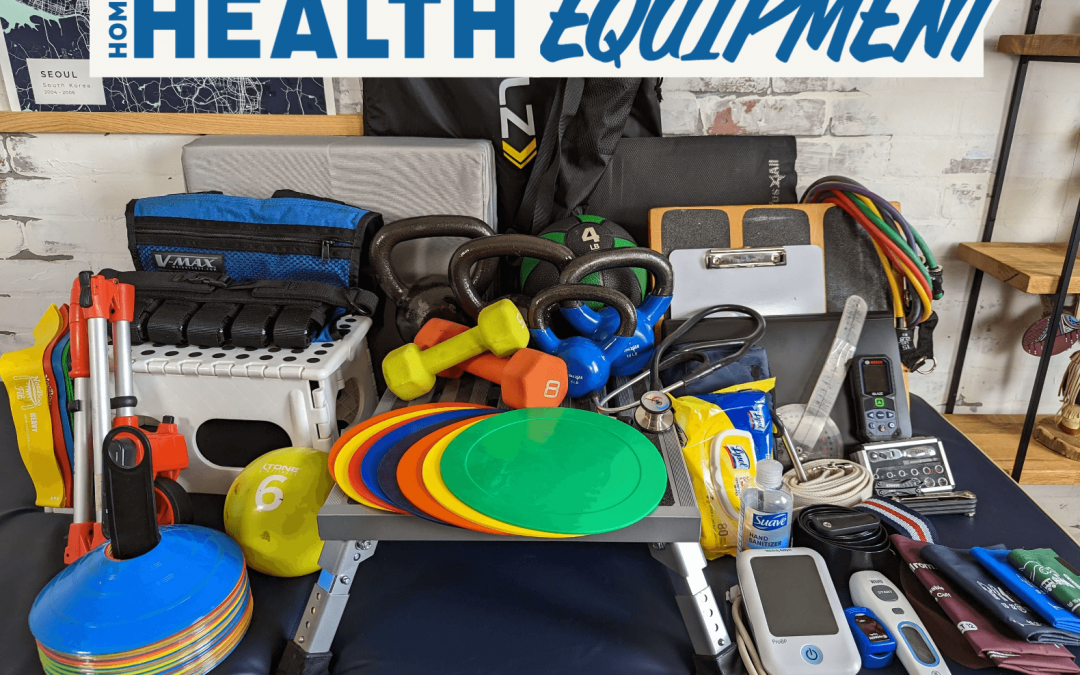Having the correct equipment to do your job is fundamental as a home health therapist. There are tools that are an absolute necessity in addition to tools that are good to acquire slowly as you go along. I’ll divide basic home health tools into three separate groups. The first group is basic items that every home health physical therapist needs to do the bare minimum job. Without these items, you won’t be able to provide appropriate and safe care. The other two groups are items that provide additional functionality and allow you to expand your interventions to provide more optimal care for your patients. I’ll also go over the equipment necessary to perform outcome measures quickly and accurately in the home.
What Basic Equipment is Needed for Home Health Therapy?
The basic tools necessary for a therapist in home health include a pulse oximeter, a validated blood pressure machine in addition to a sphygmomanometer as a backup method, a stethoscope, a thermometer, a goniometer, a gait belt, a reflex hammer, cleaning supplies, sanitation products, a measuring device, batteries, a file organizer or clipboard with storage, a pen, bag barriers, PPE, a home health bag, and resistance bands.
Where do you Get Home Health Tools?
As a full-time employee, you will likely be provided with many of these items, but if you are not, you will need to purchase them yourself. Additionally, your agency may provide you with items that are substandard, in which case you may request new equipment. If your agency refuses to provide appropriate equipment you may need to purchase some items on your own. Ultimately, these are mostly one-time costs that may be tax-deductible. Consult your tax professional.
As a part-time or PRN employee, you likely won’t be provided with many of these items and will need to obtain them on your own.
How do you know if your Home Health Equipment is Medical Grade?
When selecting equipment for taking vital signs, not all equipment is equal. There are a variety of brands and types to choose from so how do you know what’s appropriate? Let’s take a closer look at some of the more critical items in the section. As a medical professional, you should be using medical-grade equipment.

What is the Best Pulse Oximeter for Home Health?
When it comes to pulse oximeters there is a variety to choose from on Amazon, but many of those do not do as well with darker skin pigmentation. My recommendation is a Masimo MightySat or a Nonin Vantage 9590. Both of these are considered medical grade and not only handle various skin pigmentation more accurately but are faster at obtaining accurate O2 saturations when it’s important to understand your patient’s ability to adapt to exercise and movement. The Masimo has an optional respiration rate monitor that is very helpful while the Nonin is more durable and is built in the USA. While either one is suitable, I prefer the durability and reliability of the Nonin Vantage 9590 in addition to the lower cost.
What is the Best Blood Pressure Monitoring Device for Home Health?
You may have heard that manual blood pressure taking is more accurate than a machine, but that is not supported by the evidence and there is no stipulation to take blood pressure manually by the Centers for Medicare and Medicaid Services (CMS). I only take blood pressure manually as a backup and that is very rare. The most important consideration when choosing a blood pressure monitoring device is that it is a validated device. Head on over to validatebp.org to find a device that works for you. After trying 5+ devices, I’ve found the Welch Allyn ProBP 2000 and a variety of extra cuffs to be the best option. This unit typically takes BP in less than 20 seconds which helps those who are sensitive to the pressure, it is extremely well made, and in combination with extra cuffs, you can take blood pressure accurately for a variety of patients. The Student Medical Shop tends to have the best pricing and fast shipping.
What is the Best Thermometer for Home Health?
When purchasing a temporal thermometer it’s important to confirm the device is FDA “cleared” as a baseline. A touchless device is preferable to reduce contact between patients. The Wand – No Touch Forehead Thermometer by ThermoWorks is an excellent option for its durability, ease of use, large screen, and ability to change between Fahrenheit and Celcius.
Keep in mind that your agency should have a process in place to confirm the accuracy of all vital sign equipment every year.
What is the Best Gait Belt for Home Health?
Using a fabric gait belt repeatedly between patients is unsanitary. The use of a wipeable gait belt is important to reduce the risk of infection transmission between patients. There are a variety of options available, but I prefer the Posey EZ Clean gait belt due to the ease of cleaning and good clamp strength to hold the belt in place.
Basic Equipment for Outcome Measures
To properly assess your patients, you should have the necessary equipment to accurately complete objective outcome measures. Starting with a few basic items, you should be able to perform multiple valid measures.
The most fundamental tool for outcome measure assessment that a therapist should have is a laser measure. It is the fastest, most accurate way to measure distances for the timed up and go, Tinneti-POMA, 2 or 6-minute walk test, the short physical performance battery, and others. It’s compact and lightweight so doesn’t take much room in your bag and it is much faster to use than a measuring tape and more accurate than a measuring wheel. I’ve tried a variety of options, but the one I prefer is the Bosch Blaze Pro GLM165-25G. It provides a live measurement, is durable, and is highly accurate. Some others require you to press a button to find distance each time which tends to be much less convenient.
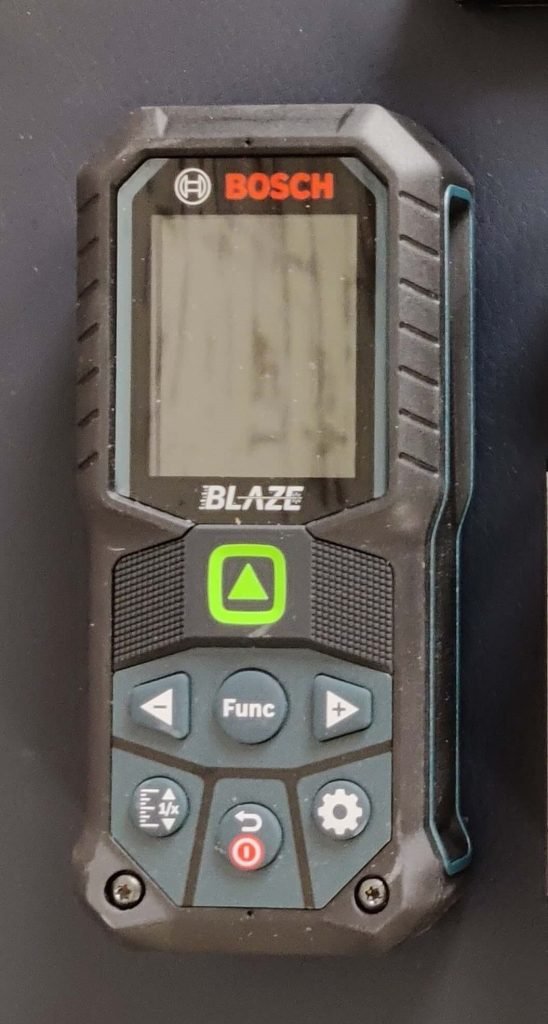
For measuring ambulation distance, especially outside, a good rolling measure such as the Komelon ML1212 which is collapsible and has a small 4” wheel is an excellent option.
With just these items you should be able to perform the following outcome measures: 5xsts, 30” CST, 2-minute step test, 2-minute walk test, 6-minute walk test, gait velocity, TUG, SPPB, and the Tinetti-POMA.
Upgrade 1 – Home Health Equipment for the Experienced Therapist
Once you’re established and have the basic equipment needs, the following items are a good next step. Round out your assessment tools with a monofilament for checking protective sense related to neuropathy. Some may consider these as a need in the basic setup, but realistically they are items not used that frequently. Additionally, if your agency has not provided one, a portable scale is helpful, especially for patients with congestive heart failure. It’s also a necessity if you will be completing OASIS documentation. I’ve found that getting a small portable scale, like the Triomph Ultra Slim, in combination with a laptop case is a very handy way to travel with the scale.
At this point it will be good to have one or more additional gait belts in the event you need additional points of control, to help lift someone from the floor, or to use as a guard when patients are ambulating with heavier weights.
Appropriate dosing in-home health has long been an issue and if you’d like to ensure your patients get the most from your interventions, this is a good time to buy some basic weights. Dumbbells or kettlebells ranging from 3 to 15 lbs are a good place to start. In the event you feel someone only needs 1-2 lbs of resistance, you can always use items in the patient’s home.
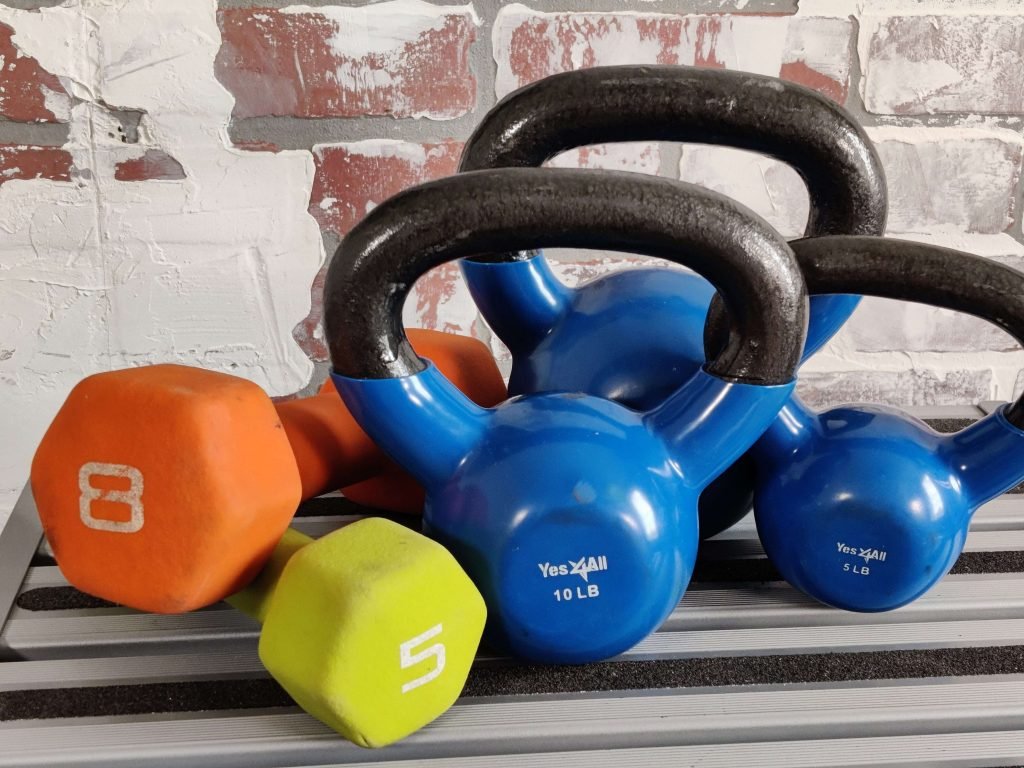
I’ve found it helpful to list out the plan for a given day so the patient knows what to expect at the beginning of each visit. It only takes a minute or two but can help the patient to feel accomplished and keep the session moving. This can be done with a dry-erase clipboard and marker. The clipboard is also helpful for filling out forms or assessments.
Equipment to help with home health maintenance
There are times when simple maintenance of assistive devices is needed to improve patient safety. This is typically to tighten brakes on walkers and wheelchairs. It just takes a couple of minutes but can be the difference in preventing a fall. The Sunex 9723 socket set is compact and works great for adjusting brakes on wheelchairs. A small multitool such as the Gerber Gear Dime Mini is just what’s needed for adjusting brakes on a 4-wheeled walker. A good hex key set is also needed at times to adjust parts of walkers and wheelchairs.
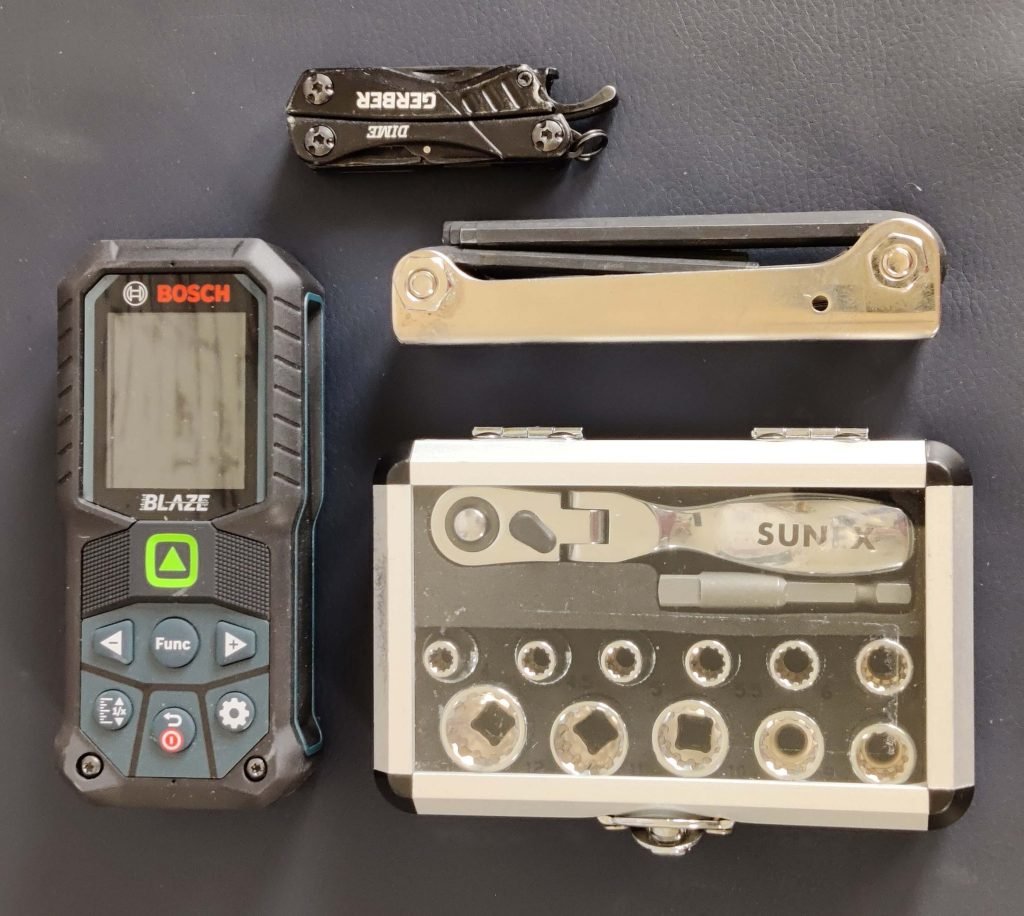
Upgrade 2 – Home Health Equipment for the Expert Therapist
Equipment for Agility and Balance
To finish out your home health equipment set-up, here’s the final group of items you should add. Cones and spot markers are great for agility and navigating obstacles. A balance pad and rocker board help address ankle and hip reaction deficits for balance. Hurdles and an agility ladder are other great tools for improving coordination and safety with obstacle navigation.
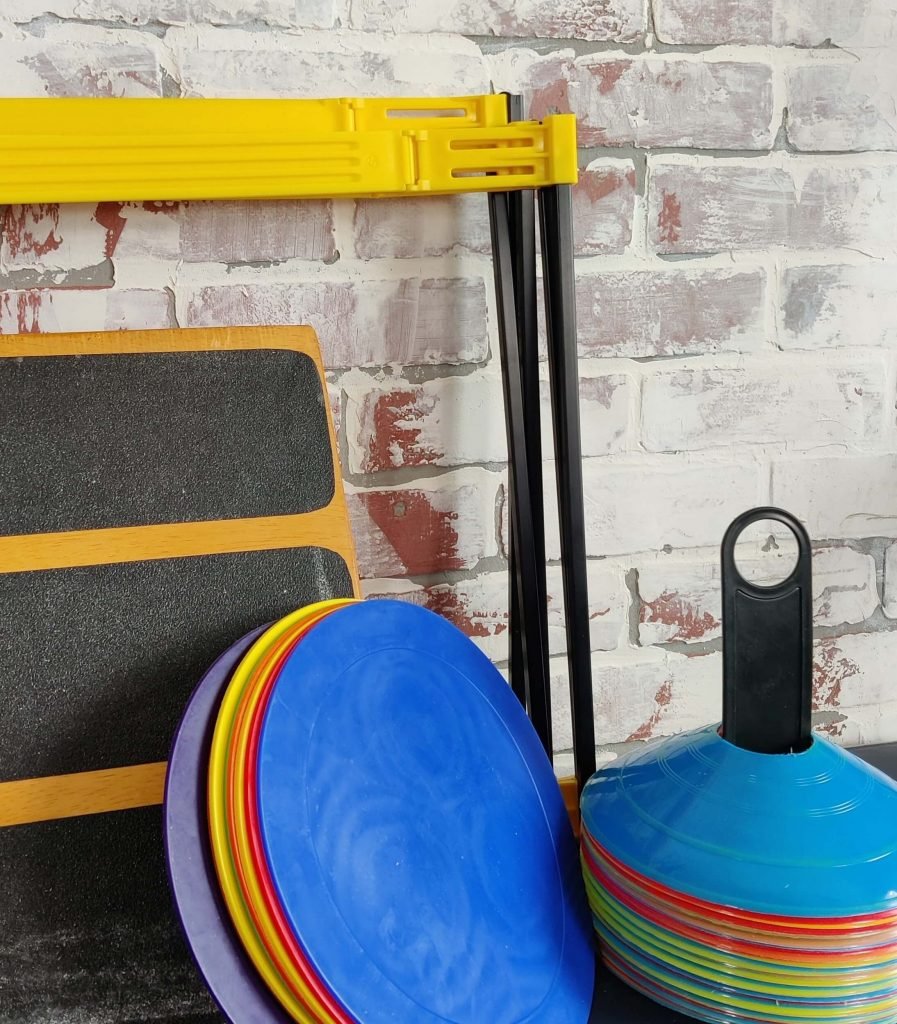
Equipment for Building Strength
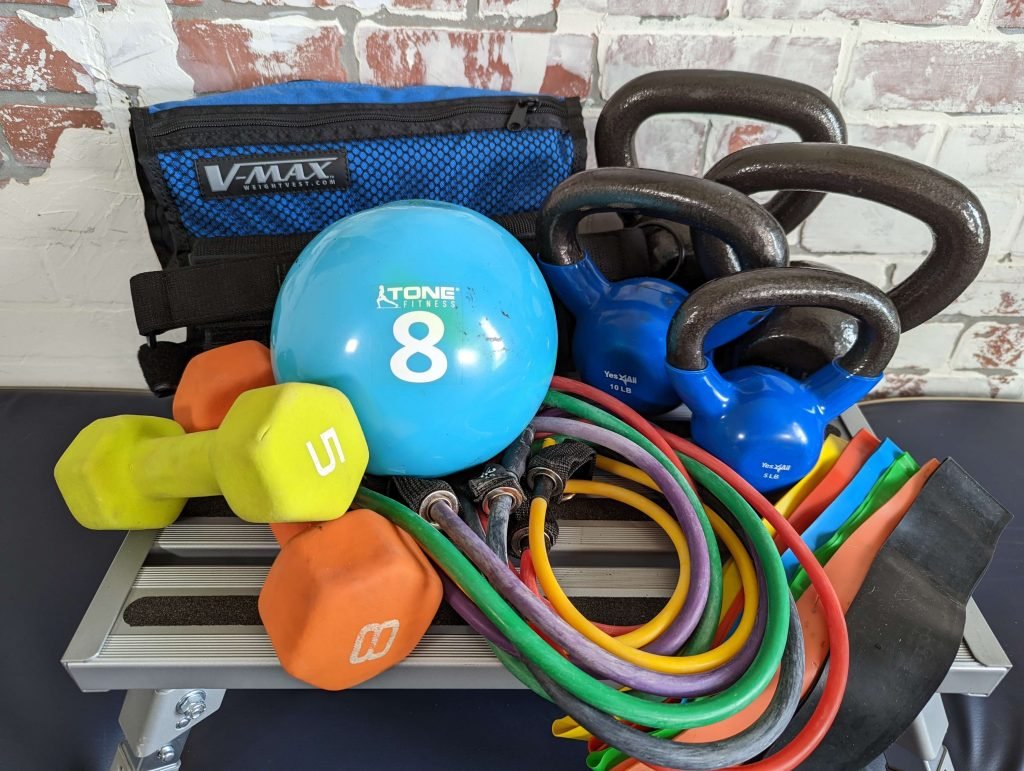
Weighted balls help to add resistance to pressing and lifting movements while making the intervention more interesting and engaging. At this point, you’ll also want to consider expanding your weights to include dumbbells or kettlebells up to 30 lbs. It’s important to understand the tasks your patient might have to do daily and ensure they can safely exceed the requirements of that task. For example, if they need to lift a 20lb basket of clothes to do the laundry, you’ll want to make sure they can lift at least 30 lbs. If they are only able to lift 20 lbs safely, they’ll be working at their maximum exertion each time they need to complete that task.
The last item you should consider adding to your home health supplies as a therapist is a high-quality adjustable weight vest. This 25lb V-MAX weight vest from weightvest.com is made in the USA of high-quality material and should last many years. Adding a weighted vest while working on gait, obstacle avoidance, balance, and agility, is an excellent way to add resistance and build functional capacity with your patients.
Consider also investing in some bodyweight suspension trainer straps. These can be easily used in homes to incorporate full-body workouts. You may also consider getting a laser level you can use to help improve step length for your patients with Parkinson’s disease.
Considerations for Home Health Therapy Equipment
While some choose to not buy any equipment at all, if you want to properly dose and challenge your patients so they can reach their maximum potential, it’s important to have the appropriate gear. Bought slowly over time, it’s easy to put together the items on this list and your patient outcomes will benefit significantly.
All equipment that comes into contact with the patient should be wipeable. At times, you may need to place a barrier between the equipment and your patient to meet sanitation standards. Equipment for taking vitals should be checked for accuracy by your agency on an annual basis.
Outcome Measure Equipment for Home Health
Aside from the Bosch Blaze Pro GLM165-25G and Komelon ML1212 noted in the basic items setup, the following are items that are required for the associated outcome measures. A small set of cones can be used for assessments that require starting, end, or turning points.
What Equipment is Needed for the Arm Curl Test?
The Arm Curl Test requires a 5lb dumbbell for women and an 8lb dumbbell for men.
What Equipment is Needed for the 4-Square Step Test?
For the 4-square step test, you’ll need either 4 canes or pipes laid out in a plus sign. For less than 10$ you can get the necessary pipe and connectors from a home improvement store. Pair that with a convenient trekking pole storage bag for easy portability.
What Equipment is Needed for the Mini BESTest?
The Mini BESTest requires the most specific equipment but is an excellent assessment for patients who are at slightly higher levels. You’ll need a 4” thick piece of Temper foam rated at medium density T41 firmness, a 9” box, and an incline ramp. For the incline ramp, you can use this aluminum step and keep two legs folded while extending the others. This can also double as a great tool for working on step-ups. For the 9” box, a 9” folding step stool is an excellent option that has the same physical dimensions as a box but is much more practical to carry in and out of patients’ homes. You should not use a standard Airex pad as it is very different in firmness and responsiveness compared to the tempered foam.
